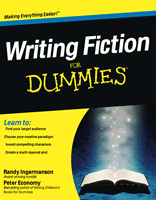Every Sunday, we profile a highly successful self-published or hybrid author to inspire other writers around the world. Today we're delighted to have Randy Ingermanson, award winning novelist and inventor of the hugely popular “snowflake method” of writing, which was highlighted on this blog a couple of weeks ago by ALLi author Richard Denning.
 Q) What's the secret of your success?
Q) What's the secret of your success?
A) A day came when I realized that my publishers weren't responsible for marketing my books — I was. Up till then, I'd just expected that they knew how to market me and it was my job to cooperate with them. But then I discovered that they didn't. For the most part, my publishers had no clue how to market my books. Sure, they could distribute the things. But they didn't know how to reach my target audience. So I made a vow that I wasn't going to publish another book until I knew how to market myself effectively. When you make a vow like that, you have no choice but to go learn marketing. And that's been huge for me.
Q) What was the single best thing you ever did?
A) Well, I saved a kid from drowning once. Does that count?But I think you're asking what's the best thing for my writing career, right? Hands-down, the best thing was to write up an article on my Snowflake Method of writing a novel and post it on my web site. At the time, I just thought it would save me the hassle of answering email about it. I had no idea it would become massively popular all around the world. That was eleven years ago and the article has been viewed about 3.8 million times. It gets 50,000 page views in a typical month. In any kind of marketing, traffic is critical. It's pretty hard to fail when you get loads of traffic. That one article has brought me quite a lot of attention and money. I had no idea that would happen.
Q) How do you get/stay in creative mode?
A) I think it was Faulkner who said, “I write when the spirit moves me, and the spirit moves me every day.” This is a lesson I have to keep relearning. You can't wait for creativity to strike. You put your butt in the chair and give yourself a word count and squeeze out the first 10 words and your muse will take it from there. Every successful writer I know has a word quota. Either daily or weekly.
A) It's easy to prioritize when you're only juggling three balls. At any given time, there's one ball heading up and one heading down and one in your hand. Your priority is the ball coming down, and you grab it with the free hand. Easy as pie. The trick is when you're juggling 8 balls, which most of us are. And most of us have no choice. So most of us are overwhelmed most of the time. I have a procedure that I call “The Overwhelm Procedure.” When I feel like I'm about to collapse because I'm totally overwhelmed and I don't have any idea what to do next, here's what I do:
- Open up my business journal (I use Scrivener) and create a new text document and then type furiously for 5 to 10 minutes, listing everything on my plate. The whole shebang. Every little detail. I keep going until I run out of panic. The goal here is to get it out of your head and onto the page.
- Edit the document so it's broken up into a set of tasks, one task per line.
- Mark each task with one asterisk if it's possible or required to do it today; two asterisks if it's possible or required to do it this week; and three if it can't be done this week.
- Today, focus on getting the one-asterisk tasks done. I can do them in any order I like, but the main thing is to get them done.
- For the rest of the week, try to tackle the two-asterisk tasks.
- Repeat the process next week until I'm no longer feeling overwhelmed.
This sounds too simple to work. What I've found is that it's just simple enough to work.
Q) What's next?
A) I'm currently editing my City of God series of novels for re-release as e-books. These were traditionally published years ago and I've got the rights back and they're next on my list to indie publish. I really like this series and don't think it needs much updating.
 Q) What's the highlight of being an author-publisher for you?
Q) What's the highlight of being an author-publisher for you?
A) I get to make the decisions. If the cover's lousy, I can replace it. If the book needs revisions, I can make them and upload the new version. If the product description isn't working, I can try something else. If the pricing is wrong, I can change it. The book is my baby and I get to raise it. Also, it's very nice to always know how each book is doing. I keep a spreadsheet showing how many units each of my books has sold and how much they've earned me. Traditional publishers just don't give you this kind of data. Knowledge is power.
Q) What's your top tip for other indie authors?
A) Don't make excuses. If something not working, figure out what's not working and make it work. If you can't figure out how to make it work, then talk to somebody who knows what they're doing and get them to mentor you. You can't ask Stephen King to do this, but you've got to have a friend who's half a rung up the ladder above you. Ask for help and be ready to give it.
Like to share this inspiring post with other author friends? Here's our suggested tweet to make it easy!
“Top tips for #selfpub writers from@SnowflakeGuy Randy Ingermanson via @IndieAuthorAlli http://wp.me/p44e6Y-1HX”





[…] Randy Ingermanson […]
Every ALLi member should read this – most author publishers (and publishers in general) confuse distribution with marketing – they are not the same thing, as this successful author clearly understands. You need distribution for the marketing to be effective, however they are a marriage in making your books sell. Bravo to this guy!
Yes, bravo Randy! And bravo to you too, Andy, for extracting this important takeaway. I also love: “the book is my baby and I get to raise it!”.